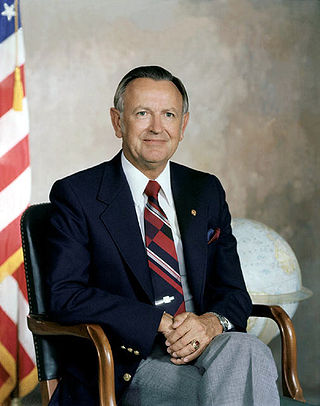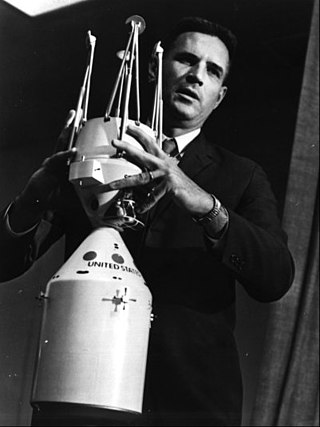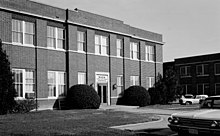
Apollo 11 was the American spaceflight that first landed humans on the Moon. Commander Neil Armstrong and lunar module pilot Buzz Aldrin landed the Apollo Lunar Module Eagle on July 20, 1969, at 20:17 UTC, and Armstrong became the first person to step onto the Moon's surface six hours and 39 minutes later, on July 21 at 02:56 UTC. Aldrin joined him 19 minutes later, and they spent about two and a quarter hours together exploring the site they had named Tranquility Base upon landing. Armstrong and Aldrin collected 47.5 pounds (21.5 kg) of lunar material to bring back to Earth as pilot Michael Collins flew the Command Module Columbia in lunar orbit, and were on the Moon's surface for 21 hours, 36 minutes before lifting off to rejoin Columbia.

The Apollo program, also known as Project Apollo, was the third United States human spaceflight program carried out by the National Aeronautics and Space Administration (NASA), which succeeded in preparing and landing the first humans on the Moon from 1968 to 1972. It was first conceived in 1960 during President Dwight D. Eisenhower's administration as a three-person spacecraft to follow the one-person Project Mercury, which put the first Americans in space. Apollo was later dedicated to President John F. Kennedy's national goal for the 1960s of "landing a man on the Moon and returning him safely to the Earth" in an address to Congress on May 25, 1961. It was the third US human spaceflight program to fly, preceded by the two-person Project Gemini conceived in 1961 to extend spaceflight capability in support of Apollo.

Human spaceflight is spaceflight with a crew or passengers aboard a spacecraft, often with the spacecraft being operated directly by the onboard human crew. Spacecraft can also be remotely operated from ground stations on Earth, or autonomously, without any direct human involvement. People trained for spaceflight are called astronauts, cosmonauts (Russian), or taikonauts (Chinese); and non-professionals are referred to as spaceflight participants or spacefarers.

The Space Race was a 20th-century competition between two Cold War rivals, the United States and the Soviet Union, to achieve superior spaceflight capability. It had its origins in the ballistic missile-based nuclear arms race between the two nations following World War II. The technological advantage demonstrated by spaceflight achievement was seen as necessary for national security, and became part of the symbolism and ideology of the time. The Space Race brought pioneering launches of artificial satellites, robotic space probes to the Moon, Venus, and Mars, and human spaceflight in low Earth orbit and ultimately to the Moon.

The Lyndon B. Johnson Space Center (JSC) is NASA's center for human spaceflight, where human spaceflight training, research, and flight control are conducted. It was renamed in honor of the late US president and Texas native, Lyndon B. Johnson, by an act of the United States Senate on February 19, 1973.

Robert Rowe Gilruth was an American aerospace engineer and an aviation/space pioneer who was the first director of NASA's Manned Spacecraft Center, later renamed the Lyndon B. Johnson Space Center.

Thomas Otten Paine was an American engineer, scientist and advocate of space exploration, and was the third Administrator of NASA, serving from March 21, 1969, to September 15, 1970.

George Michael Low was an administrator at NASA and the 14th president of the Rensselaer Polytechnic Institute. Low was one of the senior NASA officials who made numerous decisions as manager of the Apollo Spacecraft Program Office in the Apollo program of crewed missions to the Moon.

Project Gemini was NASA's second human spaceflight program. Conducted between projects Mercury and Apollo, Gemini started in 1961 and concluded in 1966. The Gemini spacecraft carried a two-astronaut crew. Ten Gemini crews and 16 individual astronauts flew low Earth orbit (LEO) missions during 1965 and 1966.

Christopher Columbus Kraft Jr. was an American aerospace and NASA engineer who was instrumental in establishing the agency's Mission Control Center and shaping its organization and culture. His protégé Glynn Lunney said in 1998: "the Control Center today ... is a reflection of Chris Kraft".

Lunar orbit rendezvous (LOR) is a process for landing humans on the Moon and returning them to Earth. It was utilized for the Apollo program missions in the 1960s and 1970s. In a LOR mission, a main spacecraft and a smaller lunar lander travel to lunar orbit. The lunar lander then independently descends to the surface of the Moon, while the main spacecraft remains in lunar orbit. After completion of the mission there, the lander returns to lunar orbit to rendezvous and re-dock with the main spacecraft, then is discarded after transfer of crew and payload. Only the main spacecraft returns to Earth.

NASA Astronaut Group 2, also known as the Next Nine and the New Nine, was the second group of astronauts selected by the National Aeronautics and Space Administration (NASA). Their selection was announced on September 17, 1962. The group augmented the Mercury Seven. President John F. Kennedy had announced Project Apollo, on May 25, 1961, with the ambitious goal of putting a man on the Moon by the end of the decade, and more astronauts were required to fly the two-man Gemini spacecraft and three-man Apollo spacecraft then under development. The Mercury Seven had been selected to accomplish the simpler task of orbital flight, but the new challenges of space rendezvous and lunar landing led to the selection of candidates with advanced engineering degrees as well as test pilot experience.

The Space Transportation System (STS), also known internally to NASA as the Integrated Program Plan (IPP), was a proposed system of reusable crewed space vehicles envisioned in 1969 to support extended operations beyond the Apollo program.. The purpose of the system was two-fold: to reduce the cost of spaceflight by replacing the current method of launching capsules on expendable rockets with reusable spacecraft; and to support ambitious follow-on programs including permanent orbiting space stations around Earth and the Moon, and a human landing mission to Mars.

Space Center Houston is a science museum that serves as the official visitor center of NASA Johnson Space Center in Houston. It was designated a Smithsonian Affiliate museum in 2014. The organization is owned by NASA, and operated under a contract by the nonprofit Manned Spaceflight Education Foundation, a 501(c)(3) organization. The Johnson Space Center is the home of Mission Control and astronaut training.

Joseph Francis Shea was an American aerospace engineer and NASA manager. Born in the New York City borough of the Bronx, he was educated at the University of Michigan, receiving a Ph.D. in Engineering Mechanics in 1955. After working for Bell Labs on the radio inertial guidance system of the Titan I intercontinental ballistic missile, he was hired by NASA in 1961. As Deputy Director of NASA's Office of Manned Space Flight, and later as head of the Apollo Spacecraft Program Office, Shea played a key role in shaping the course of the Apollo program, helping to lead NASA to the decision in favor of lunar orbit rendezvous and supporting "all up" testing of the Saturn V rocket. While sometimes causing controversy within the agency, Shea was remembered by his former colleague George Mueller as "one of the greatest systems engineers of our time".

The National Aeronautics and Space Administration is an independent agency of the U.S. federal government responsible for the civil space program, aeronautics research, and space research.

The space policy of the United States includes both the making of space policy through the legislative process, and the implementation of that policy in the United States' civilian and military space programs through regulatory agencies. The early history of United States space policy is linked to the US–Soviet Space Race of the 1960s, which gave way to the Space Shuttle program. At the moment, the US space policy is aimed at the exploration of the Moon and the subsequent colonization of Mars.

Tecwyn Roberts was a Welsh spaceflight engineer who in the 1960s played important roles in designing the Mission Control Center at NASA's Johnson Space Center in Houston, Texas and creating NASA's worldwide tracking and communications network.
There are NASA facilities across the United States and around the world. NASA Headquarters in Washington, DC provides overall guidance and political leadership to the agency. There are 10 NASA field centers, which provide leadership for and execution of NASA's work. All other facilities fall under the leadership of at least one of these field centers. Some facilities serve more than one application for historic or administrative reasons. NASA has used or supported various observatories and telescopes, and an example of this is the NASA Infrared Telescope Facility. In 2013 a NASA Office of the Inspector General's (OIG) Report recommended a Base Realignment and Closure Commission (BRAC) style organization to consolidate NASA's little used facilities. The OIG determined at least 33 of NASA's 155 facilities were underutilized.




















